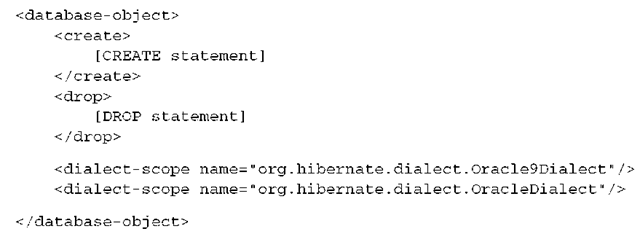Many examples presented in this topic are about “difficult” mappings. The first time you’ll likely have problems creating a mapping is with a legacy database schema that can’t be modified. We discuss typical issues you encounter in such a scenario and how you can bend and twist your mapping metadata instead of changing your application or database schema.
We also show you how you can override the SQL Hibernate generates automatically. This includes SQL queries, DML (create, update, delete) operations, as well as Hibernate’s automatic DDL-generation feature. You’ll see how to map stored procedures and user-defined SQL functions, and how to apply the right integrity rules in your database schema. This section will be especially useful if your DBA needs full control (or if you’re a DBA and want to optimize Hibernate at the SQL level).
As you can see, the topics in this topic are diverse; you don’t have to read them all at once. You can consider a large part of this topic to be reference material and come back when you face a particular issue.
Integrating legacy databases
In this section, we hope to cover all the things you may encounter when you have to deal with an existing legacy database or (and this is often synonymous) a weird or broken schema. If your development process is top-down, however, you may want to skip this section. Furthermore, we recommend that you first read all topics about class, collection, and association mappings before you attempt to reverse-engineer a complex legacy schema.
We have to warn you: When your application inherits an existing legacy database schema, you should usually make as few changes to the existing schema as possible. Every change that you make to the schema could break other existing applications that access the database. Possibly expensive migration of existing data is also something you need to evaluate. In general, it isn’t possible to build a new application and make no changes to the existing data model—a new application usually means additional business requirements that naturally require evolution of the database schema.
We’ll therefore consider two types of problems: problems that relate to the changing business requirements (which generally can’t be solved without schema changes) and problems that relate only to how you wish to represent the same business problem in your new application (these can usually, but not always, be solved without database schema changes). It should be clear that the first kind of problem is usually visible by looking at just the logical data model. The second more often relates to the implementation of the logical data model as a physical database schema.
If you accept this observation, you’ll see that the kinds of problems that require schema changes are those that necessitate addition of new entities, refactoring of existing entities, addition of new attributes to existing entities, and modification to the associations between entities. The problems that can be solved without schema changes usually involve inconvenient table or column definitions for a particular entity. In this section, we’ll concentrate on these kinds of problems.
We assume that you’ve tried to reverse-engineer your existing schema with the Hibernate toolset, “Reverse engineering a legacy database.” The concepts and solutions discussed in the following sections assume that you have basic object/relational mapping in place and that you need to make additional changes to get it working. Alternatively, you can try to write the mapping completely by hand without the reverse-engineering tools.
Let’s start with the most obvious problem: legacy primary keys.
Handling primary keys
We’ve already mentioned that we think natural primary keys can be a bad idea. Natural keys often make it difficult to refactor the data model when business requirements change. They may even, in extreme cases, impact performance. Unfortunately, many legacy schemas use (natural) composite keys heavily and, for the reason we discourage the use of composite keys, it may be difficult to change the legacy schema to use noncomposite natural or surrogate keys.
Therefore, Hibernate supports the use of natural keys. If the natural key is a composite key, support is via the <composite-id> mapping. Let’s map both a composite and a noncomposite natural primary key.
Mapping a natural key
If you encountered a USERS table in a legacy schema, it’s likely that USERNAME is the actual primary key. In this case, you have no surrogate identifier that is automatically generated. Instead, you enable the assigned identifier generator strategy to indicate to Hibernate that the identifier is a natural key assigned by the application before the object is saved:
The code to save a new User is as follows:
How does Hibernate know that saveOrUpdate() requires an INSERT and not an UPDATE? It doesn’t, so a trick is needed: Hibernate queries the USERS table for the given username, and if it’s found, Hibernate updates the row. If it isn’t found, insertion of a new row is required and done. This is certainly not the best solution, because it triggers an additional hit on the database.
Several strategies avoid the SELECT:
■ Add a <version> or a <timestamp> mapping, and a property, to your entity. Hibernate manages both values internally for optimistic concurrency control (discussed later in the topic). As a side effect, an empty timestamp or a 0 or NULL version indicates that an instance is new and has to be inserted, not updated.
■ Implement a Hibernate Interceptor, and hook it into your Session. This extension interface allows you to implement the method isTransient() with any custom procedure you may need to distinguish old and new objects.
On the other hand, if you’re happy to use save() and update() explicitly instead of saveOrUpdate(), Hibernate doesn’t have to distinguish between transient and detached instances—you do this by selecting the right method to call. (This issue is, in practice, the only reason to not use saveOrUpdate() all the time, by the way.)
Mapping natural primary keys with JPA annotations is straightforward:
@Id private String username;
If no identifier generator is declared, Hibernate assumes that it has to apply the regular select-to-determine-state-unless-versioned strategy and expects the application to take care of the primary key value assignment. You can again avoid the SELECT by extending your application with an interceptor or by adding a version-control property (version number or timestamp).
Composite natural keys extend on the same ideas.
Mapping a composite natural key
Suppose that the primary key of the USERS table consists of a USERNAME and DEPARTMENT_NR. You can add a property named departmentNr to the User class and create the following mapping:
The code to save a new User looks like this:
Again, keep in mind that Hibernate executes a SELECT to determine what save-OrUpdate() should do—unless you enable versioning control or a custom Interceptor. But what object can/should you use as the identifier when you call load() or get() ? Well, it’s possible to use an instance of the User class, for example:
In this code snippet, User acts as its own identifier class. It’s more elegant to define a separate composite identifier class that declares just the key properties. Call this class UserId:
It’s critical that you implement equals() and hashCode() correctly, because Hibernate relies on these methods for cache lookups. Identifier classes are also expected to implement Serializable.
You now remove the username and departmentNr properties from User anc add a userId property. Create the following mapping:
Save a new instance of User with this code:
Again, a SELECT is needed for saveOrUpdate() to work. The following code shows how to load an instance:
Now, suppose that the DEPARTMENT_NR is a foreign key referencing the DEPARTMENT table, and that you wish to represent this association in the Java domain model as a many-to-one association.
Foreign keys in composite primary keys
We recommend that you map a foreign key column that is also part of a composite primary key with a regular <many-to-one> element, and disable any Hibernate inserts or updates of this column with insert=”false” update=”false”, as follows:
Hibernate now ignores the department property when updating or inserting a User, but you can of course read it with johndoe.getDepartment(). The relationship between a User and Department is now managed through the departmentId property of the UserId composite key class:
Only the identifier value of the department has any effect on the persistent state; the setDepartment(department) call is done for consistency: Otherwise, you’d have to refresh the object from the database to get the department set after the flush. (In practice you can move all these details into the constructor of your composite identifier class.)
An alternative approach is a <key-many-to-one>:
However, it’s usually inconvenient to have an association in a composite identifier class, so this approach isn’t recommended except in special circumstances. The <key-many-to-one> construct also has limitations in queries: You can’t restrict a query result in HQL or Criteria across a <key-many-to-one> join (although it’s possible these features will be implemented in a later Hibernate version).
Foreign keys to composite primary keys
Because USERS has a composite primary key, any referencing foreign key is also composite. For example, the association from Item to User (the seller) is now mapped with a composite foreign key.
Hibernate can hide this detail from the Java code with the following association mapping from Item to User:
Note that the order in which columns are listed is important and should match the order in which they appear in the <composite-id> element of the primary key mapping of User.
This completes our discussion of the basic composite key mapping technique in Hibernate. Mapping composite keys with annotations is almost the same, but as always, small differences are important.
Composite keys with annotations
The JPA specification covers strategies for handling composite keys. You have three options:
■ Encapsulate the identifier properties in a separate class and mark it @Embeddable, like a regular component. Include a property of this component type in your entity class, and map it with @Id for an application-assigned strategy.
■ Encapsulate the identifier properties in a separate class without any annotations on it. Include a property of this type in your entity class, and map it with @EmbeddedId.
■ Encapsulate the identifier properties in a separate class. Now—and this is different that what you usually do in native Hibernate—duplicate all the identifier properties in the entity class. Then, annotate the entity class with @IdClass and specify the name of your encapsulated identifier class.
The first option is straightforward. You need to make the UserId class from the previous section embeddable:
Any collection owned by the User class also has a composite foreign key—foi example, the inverse association, items, sold by this user:
As for all component mappings, you can define extra mapping attributes on the fields (or getter methods) of this class. To map the composite key of User, set the generation strategy to application assigned by omitting the @GeneratedValue annotation:
Just as you did with regular component mappings earlier in the topic, you can override particular attribute mappings of the component class, if you like.
The second composite-key mapping strategy doesn’t require that you mark up the UserId primary key class. Hence, no @Embeddable and no other annotation on that class is needed. In the owning entity, you map the composite identifier property with @EmbeddedId, again, with optional overrides:
In a JPA XML descriptor, this mapping looks as follows:
The third composite-key mapping strategy is a bit more difficult to understand, especially for experienced Hibernate users. First, you encapsulate all identifier attributes in a separate class—as in the previous strategy, no extra annotations on that class are needed. Now you duplicate all the identifier properties in the entity class:
Hibernate inspects the @IdClass and singles out all the duplicate properties (by comparing name and type) as identifier properties and as part of the primary key. All primary key properties are annotated with @Id, and depending on the position of these elements (field or getter method), the entity defaults to field or property access.
Note that this last strategy is also available in Hibernate XML mappings; however, it’s somewhat obscure:
You omit the identifier property name of the entity (because there is none), so Hibernate handles the identifier internally. With mapped=”true”, you enable the last JPA mapping strategy, so all key properties are now expected to be present in both the User and the UserId classes.
Because we didn’t find a compelling case for this last strategy defined in Java Persistence, we have to assume that it was added to the specification to support some legacy behavior (EJB 2.x entity beans).
Composite foreign keys are also possible with annotations. Let’s first map the association from Item to User:
The primary difference between a regular @ManyToOne and this mapping is the number of columns involved—again, the order is important and should be the same as the order of the primary key columns. However, if you declare the refer-encedColumnName for each column, order isn’t important, and both the source and target tables of the foreign key constraint can have different column names.
The inverse mapping from User to Item with a collection is even more straightforward:
This inverse side needs the mappedBy attribute, as usual for bidirectional associations. Because this is the inverse side, it doesn’t need any column declarations. In legacy schemas, a foreign key often doesn’t reference a primary key.
Foreign key referencing nonprimary keys
Usually, a foreign key constraint references a primary key. A foreign key constraint is an integrity rule that guarantees that the referenced table has one row with a key value that matches the key value in the referencing table and given row. Note that a foreign key constraint can be self-referencing; in other words, a column with a foreign key constraint can reference the primary key column of the same table. (The PARENT_CATEGORY_ID in the CaveatEmptor CATEGORY table is one example.)
This composite identifier mapping strategy looks as follows if you use JPA XML descriptors:
Legacy schemas sometimes have foreign key constraints that don’t follow the simple “FK references PK” rule. Sometimes a foreign key references a nonprimary key: a simple unique column, a natural nonprimary key. Let’s assume that in Cave-atEmptor, you need to handle a legacy natural key column called CUSTOMER_NR on the USERS table:
The only thing that is probably new to you in this mapping is the unique attribute. This is one of the SQL customization options in Hibernate; it’s not used at runtime (Hibernate doesn’t do any uniqueness validation) but to export the database schema with hbm2ddl. If you have an existing schema with a natural key, you assume that it’s unique. For completeness, you can and should repeat such important constraints in your mapping metadata—maybe you’ll use it one day to export a fresh schema.
Equivalent to the XML mapping, you can declare a column as unique in JPA annotations:
The next issue you may discover in the legacy schema is that the ITEM table has a foreign key column, SELLER_NR. In an ideal world, you would expect this foreign key to reference the primary key, USER_ID, of the USERS table. However, in a legacy schema, it may reference the natural unique key, CUSTOMER_NR. You need to map it with a property reference:
You’ll encounter the property-ref attribute in more exotic Hibernate mappings. It’s used to tell Hibernate that “this is a mirror of the named property.” In the previous example, Hibernate now knows the target of the foreign key reference. One further thing to note is that property-ref requires the target property to be unique, so unique=”true”, as shown earlier, is needed for this mapping.
If you try to map this association with JPA annotations, you may look for an equivalent to the property-ref attribute. You map the association with an explicit reference to the natural key column, CUSTOMER_NR:
Hibernate now knows that the referenced target column is a natural key and manages the foreign key relationship accordingly.
To complete this example, you make this association mapping between the two classes bidirectional, with a mapping of an itemsForAuction collection on the User class. First, here it is in XML:
Again the foreign key column in ITEM is mapped with a property reference to customerNr. In annotations, this is a lot easier to map as an inverse side:
Composite foreign key referencing nonprimary keys
Some legacy schemas are even more complicated than the one discussed before: A foreign key might be a composite key and, by design, reference a composite natural nonprimary key!
Let’s assume that USERS has a natural composite key that includes the FIRST-NAME, LASTNAME, and BIRTHDAY columns. A foreign key may reference this natural key, as shown in figure 8.1.
To map this, you need to group several properties under the same name—otherwise you can’t name the composite in a property-ref. Apply the <properties> element to group the mappings:
Figure 8.1 A composite foreign key references a composite primary key.
As you can see, the <properties> element is useful not only to give several properties a name, but also to define a multicolumn unique constraint or to make several properties immutable. For the association mappings, the order of columns is again important:
Fortunately, it’s often straightforward to clean up such a schema by refactoring foreign keys to reference primary keys—if you can make changes to the database that don’t disturb other applications sharing the data.
This completes our exploration of natural, composite, and foreign key-related problems you may have to deal with when you try to map a legacy schema. Let’s move on to other interesting special mapping strategies.
Sometimes you can’t make any changes to a legacy database—not even creating tables or views. Hibernate can map classes, properties, and even parts of associations to a simple SQL statement or expression. We call these kinds of mappings formula mappings.
Arbitrary join conditions with formulas
Mapping a Java artifact to an SQL expression is useful for more than integrating a legacy schema. You created two formula mappings already: The first, “Using derived properties,” was a simple derived read-only property mapping.
You’ll now apply formulas for a more exotic purposes. Keep in mind that some of the mappings you’ll see now are complex, and you may be better prepared to understand them after reading all the topics in part 2 of this topic.
Understanding the use case
You now map a literal join condition between two entities. This sounds more complex than it is in practice. Look at the two classes shown in figure 8.2.
A particular Item may have several Bids—this is a one-to-many association. But it isn’t the only association between the two classes; the other, a unidirectional one-to-one, is needed to single out one particular Bid instance as the winning bid. You map the first association because you’d like to be able to get all the bids for an auctioned item by calling anItem.getBids(). The second association allows you to call anItem.getSuccessfulBid(). Logically, one of the elements in the collection is also the successful bid object referenced by getSuccessfulBid().
The first association is clearly a bidirectional one-to-many/many-to-one association, with a foreign key ITEM_ID in the BID table.
The one-to-one association is more difficult; you can map it several ways. The most natural is a uniquely constrained foreign key in the ITEM table referencing a row in the BID table—the winning row, for example a SUCCESSFUL_ BID_ID column.
Legacy schemas often need a mapping that isn’t a simple foreign key relationship.
Mapping a formula join condition
Imagine that each row in the BID table has a flag column to mark the winning bid, as shown in figure 8.3. One BID row has the flag set to true, and all other rows for this auction item are naturally false. Chances are good that you won’t find a constraint or an integrity rule for this relationship in a legacy schema, but we ignore this for now and focus on the mapping to Java classes.
To make this mapping even more interesting, assume that the legacy schema didn’t use the SQL BOOLEAN datatype but a CHAR(1) field and the values T (for true) and F (for false) to simulate the boolean switch. Your goal is to map this flag column to a successfulBid property of the Item class. To map this as an object reference, you need a literal join condition, because there is no foreign key Hibernate can use for a join. In other words, for each ITEM row, you need to join a row from the BID table that has the SUCCESSFUL flag set to T. If there is no such row, the anItem.getSuccessfulBid() call returns null.
Let’s first map the Bid class and a successful boolean property to the SUCCESSFUL database column:
Figure 8.3
The winning bid is marked with the SUCCESSFUL column flag.
The type=”true_false” attribute creates a mapping between a Java boolean primitive (or its wrapper) property and a simple CHAR(1) column with T/F literal values—it’s a built-in Hibernate mapping type. You again group several properties with <properties> under a name that you can reference in other mappings. What is new here is that you can group a <many-to-one>, not only basic properties.
The real trick is happening on the other side, for the mapping of the success-fulBid property of the Item class:
Ignore the <set> association mapping in this example; this is the regular one-to-many association between Item and Bid, bidirectional, on the ITEM_ID foreign key column in BID.
NOTE Isn’t <one-to-one> used for primary key associations? Usually, a <one-to-one> mapping is a primary key relationship between two entities, when rows in both entity tables share the same primary key value. However, by using a formula with a property-ref, you can apply it to a foreign key relationship. In the example shown in this section, you could replace the <one-to-one> element with <many-to-one>, and it would still work.
The interesting part is the <one-to-one> mapping and how it relies on a prop-erty-ref and literal formula values as a join condition when you work with the association.
Working with the association
The full SQL query for retrieval of an auction item and its successful bid looks like this:
When you load an Item, Hibernate now joins a row from the BID table by applying a join condition that involves the columns of the successful Reference property. Because this is a grouped property, you can declare individual expressions for each of the columns involved, in the right order. The first one, ‘T’, is a literal, as you can see from the quotes. Hibernate now includes ‘T’ = SUCCESSFUL in the join condition when it tries to find out whether there is a successful row in the BID table. The second expression isn’t a literal but a column name (no quotes).
Hence, another join condition is appended: i.ITEM_ID = b.ITEM_ID. You can expand this and add more join conditions if you need additional restrictions.
Note that an outer join is generated because the item in question may not have a successful bid, so NULL is returned for each b.* column. You can now call anItem.getSuccessfulBid() to get a reference to the successful bid (or null if none exists).
Finally, with or without database constraints, you can’t just implement an item.setSuccessfulBid() method that only sets the value on a private field in the Item instance. You have to implement a small procedure in this setter method that takes care of this special relationship and the flag property on the bids:
When setSuccessfulBid() is called, you set all bids to not successful. Doing so may trigger the loading of the collection—a price you have to pay with this strategy. Then, the new successful bid is marked and set as an instance variable. Setting the flag updates the SUCCESSFUL column in the BID table when you save the objects. To complete this (and to fix the legacy schema), your database-level constraints need to do the same as this method. (We’ll come back to constraints later in this topic.)
One of the things to remember about this literal join condition mapping is that it can be applied in many other situations, not only for successful or default relationships. Whenever you need some arbitrary join condition appended to your queries, a formula is the right choice. For example, you could use it in a
<many-to-many> mapping to create a literal join condition from the association table to the entity table(s).
Unfortunately, at the time of writing, Hibernate Annotations doesn’t support arbitrary join conditions expressed with formulas. The grouping of properties under a reference name also wasn’t possible. We expect that these features will closely resemble the XML mapping, once they’re available.
Another issue you may encounter in a legacy schema is that it doesn’t integrate nicely with your class granularity. Our usual recommendation to have more classes than tables may not work, and you may have to do the opposite and join arbitrary tables into one class.
Joining arbitrary tables
We’ve already shown the <join> mapping element in an inheritance mapping. “Mixing inheritance strategies.” It helped to break out properties of a particular subclass into a separate table, out of the primary inheritance hierarchy table. This generic functionality has more uses—however, we have to warn you that <join> can also be a bad idea. Any properly designed system should have more classes than tables. Splitting a single class into separate tables is something you should do only when you need to merge several tables in a legacy schema into a single class.
Moving properties into a secondary table
Suppose that in CaveatEmptor, you aren’t keeping a user’s address information with the user’s main information in the USERS table, mapped as a component, but in a separate table. This is shown in figure 8.4. Note that each BILLING_ADDRESS has a foreign key USER_ID, which is in turn the primary key of the BILLING_ ADDRESS table.
To map this in XML, you need to group the properties of the Address in a <join> element:
Figure 8.4
Breaking out the billing address data into a secondary table
You don’t have to join a component; you can as well join individual properties or even a <many-to-one> (we did this in the previous topic for optional entity associations). By setting optional=”true”, you indicate that the component property may also be null for a User with no billingAddress, and that no row should then be inserted into the secondary table. Hibernate also executes an outer join instead of an inner join to retrieve the row from the secondary table. If you declared fetch=”select” on the <join> mapping, a secondary select would be used for that purpose.
The notion of a secondary table is also included in the Java Persistence specification. First, you have to declare a secondary table (or several) for a particular entity:
Each secondary table needs a name and a join condition. In this example, a foreign key column references the primary key column of the USERS table, just like earlier in the XML mapping. (This is the default join condition, so you can only declare the secondary table name, and nothing else). You can probably see that the syntax of annotations is starting to become an issue and code is more difficult to read. The good news is that you won’t have to use secondary tables often.
The actual component property, billingAddress, is mapped as a regular @Embedded class, just like a regular component. However, you need to override each component property column and assign it to the secondary table, in the User class:
This is no longer easily readable, but it’s the price you pay for mapping flexibility with declarative metadata in annotations. Or, you can use a JPA XML descriptor:
Another, even more exotic use case for the <join> element is inverse joined properties or components.
verse joined properties
Let’s assume that in CaveatEmptor you have a legacy table called DAILY_BILLING. This table contains all the open payments, executed in a nightly batch, for any auctions. The table has a foreign key column to ITEM, as you can see in figure 8.5.
Each payment includes a TOTAL column with the amount of money that will be billed. In CaveatEmptor, it would be convenient if you could access the price of a particular auction by calling anItem.getBillingTotal().
You can map the column from the DAILY_BILLING table into the Item class. However, you never insert or update it from this side; it’s read-only. For that reason, you map it inverse—a simple mirror of the (supposed, you don’t map it here) other side that takes care of maintaining the column value:
Figure 8.5 The daily billing summary references an item and contains the total sum.
The main difference is the SQL SELECT used to load an ITEM: The first solution defaults to an outer join, with an optional second SELECT if you enable <join fetch=”select”>. The derived property results in an embedded subselect in the select clause of the original query. At the time of writing, inverse join mappings aren’t supported with annotations, but you can use a Hibernate annotation for formulas.
As you can probably guess from the examples, <join> mappings come in handy in many situations. They’re even more powerful if combined with formulas, but we hope you won’t have to use this combination often.
One further problem that often arises in the context of working with legacy data are database triggers.
Working with triggers
There are some reasons for using triggers even in a brand-new database, so legacy data isn’t the only scenerio in which they can cause problems. Triggers and object state management with an ORM software are almost always an issue, because triggers may run at inconvenient times or may modify data that isn’t synchronized with the in-memory state.
Triggers that run on INSERT
Suppose the ITEM table has a CREATED column, mapped to a created property of type Date, that is initialized by a trigger that executes automatically on insertion. The following mapping is appropriate:
Notice that you map this property insert=11 false11 update=11 false11 to indicate that it isn’t to be included in SQL INSERT or UPDATEs by Hibernate.
After saving a new Item, Hibernate isn’t aware of the value assigned to this column by the trigger, because it occurred after the INSERT of the item row.
Note that an alternative solution for this problem is a derived property using a formula expression and a correlated subquery:
need the generated value in the application, you must explicitly tell Hibernate to reload the object with an SQL SELECT. For example:
Most problems involving triggers may be solved in this way, using an explicit flush() to force immediate execution of the trigger, perhaps followed by a call to refresh() to retrieve the result of the trigger.
Before you add refresh() calls to your application, we have to tell you that the primary goal of the previous section was to show you when to use refresh(). Many Hibernate beginners don’t understand its real purpose and often use it incorrectly. A more formal definition of refresh() is “refresh an in-memory instance in persistent state with the current values present in the database.”
For the example shown, a database trigger filling a column value after insertion, a much simpler technique can be used:
With annotations, use a Hibernate extension:
We have already discussed the generated attribute in detail “Generated and default property values.” With gener-ated=”insert”, Hibernate automatically executes a SELECT after insertion, to retrieve the updated state.
There is one further problem to be aware of when your database executes triggers: reassociation of a detached object graph and triggers that run on each UPDATE.
Triggers that run on UPDATE
Before we discuss the problem of ON UPDATE triggers in combination with reattachment of objects, we need to point out an additional setting for the generated attribute:
With annotations, the equivalent mappings are as follows:
With always, you enable Hibernate’s automatic refreshing not only for insertion but also for updating of a row. In other words, whenever a version, timestamp, or any property value is generated by a trigger that runs on UPDATE SQL statements, you need to enable this option. Again, refer to our earlier discussion of generated properties in section 4.4.1.
Let’s look at the second issue you may run into if you have triggers running on updates. Because no snapshot is available when a detached object is reattached to a new Session (with update() or saveOrUpdate()), Hibernate may execute unnecessary SQL UPDATE statements to ensure that the database state is synchronized with the persistence context state. This may cause an UPDATE trigger to fire inconveniently. You avoid this behavior by enabling select-before-update in the mapping for the class that is persisted to the table with the trigger. If the ITEM table has an update trigger, add the following attribute to your mapping:
This setting forces Hibernate to retrieve a snapshot of the current database state using an SQL SELECT, enabling the subsequent UPDATE to be avoided if the state of the in-memory Item is the same. You trade the inconvenient UPDATE for an additional SELECT.
A Hibernate annotation enables the same behavior:
Before you try to map a legacy scheme, note that the SELECT before an update only retrieves the state of the entity instance in question. No collections or associated instances are eagerly fetched, and no prefetching optimization is active. If you start enabling selectBeforeUpdate for many entities in your system, you’ll probably find that the performance issues introduced by the nonoptimized selects are problematic. A better strategy uses merging instead of reattachment. Hibernate can then apply some optimizations (outer joins) when retrieving database snapshots. We’ll talk about the differences between reattachment and merging later in the topic in more detail.
Let’s summarize our discussion of legacy data models: Hibernate offers several strategies to deal with (natural) composite keys and inconvenient columns easily. Before you try to map a legacy schema, our recommendation is to carefully examine whether a schema change is possible. In our experience, many developers immediately dismiss database schema changes as too complex and time-consuming and look for a Hibernate solution. This sometimes isn’t justified, and you should consider schema evolution a natural part of your schema’s lifecycle. If tables change, then a data export, some transformation, and an import may solve the problem. One day of work may save many days in the long run.
Legacy schemas often also require customization of the SQL generated by Hibernate, be it for data manipulation (DML) or schema definition (DDL).
Customizing SQL
SQL started its life in the 1970s but wasn’t (ANSI) standardized until 1986. Although each update of the SQL standard has seen new (and many controversial) features, every DBMS product that supports SQL does so in its own unique way. The burden of portability is again on the database application developers. This is where Hibernate helps: Its built-in query mechanisms, HQL and the Criteria API, produce SQL that depends on the configured database dialect. All other automatically generated SQL (for example, when a collection has to be retrieved on demand) is also produced with the help of dialects. With a simple switch of the dialect, you can run your application on a different DBMS.
To support this portability, Hibernate has to handle three kinds of operations:
■ Every data-retrieval operation results in SELECT statements being executed. Many variations are possible; for example, database products may use a different syntax for the join operation or how a result can be limited to a particular number of rows.
■ Every data modification requires the execution of Data Manipulation Language (DML) statements, such as UPDATE, INSERT, and DELETE. DML often isn’t as complex as data retrieval, but it still has product-specific variations.
■ A database schema must be created or altered before DML and data retrieval can be executed. You use Data Definition Language (DDL) to work on the database catalog; it includes statements such as CREATE, ALTER, and DROP. DDL is almost completely vendor specific, but most products have at least a similar syntax structure.
Another term we use often is CRUD, for create, read, update, and delete. Hibernate generates all this SQL for you, for all CRUD operations and schema definition. The translation is based on an org.hibernate.dialect.Dialect implementation—Hibernate comes bundled with dialects for all popular SQL database management systems. We encourage you to look at the source code of the dialect you’re using; it’s not difficult to read. Once you’re more experienced with
Hibernate, you may even want to extend a dialect or write your own. For example, to register a custom SQL function for use in HQL selects, you’d extend an existing dialect with a new subclass and add the registration code—again, check the existing source code to find out more about the flexibility of the dialect system.
On the other hand, you sometimes need more control than Hibernate APIs (or HQL) provide, when you need to work on a lower level of abstraction. With Hibernate you can override or completely replace all CRUD SQL statements that will be executed. You can customize and extend all DDL SQL statements that define your schema, if you rely on Hibernate’s automatic schema-export tool (you don’t have to).
Furthermore Hibernate allows you to get a plain JDBC Connection object at all times through session.connection(). You should use this feature as a last resort, when nothing else works or anything else would be more difficult than plain JDBC. With the newest Hibernate versions, this is fortunately exceedingly rare, because more and more features for typical stateless JDBC operations (bulk updates and deletes, for example) are built-in, and many extension points for custom SQL already exist.
This custom SQL, both DML and DDL, is the topic of this section. We start with custom DML for create, read, update, and delete operations. Later, we integrate stored database procedures to do the same work. Finally, we look at DDL customization for the automatic generation of a database schema and how you can create a schema that represents a good starting point for the optimization work of a DBA.
Note that at the time of writing this detailed customization of automatically generated SQL isn’t available in annotations; hence, we use XML metadata exclusively in the following examples. We expect that a future version of Hibernate Annotations will include better support for SQL customization.
Writing custom CRUD statements
The first custom SQL you’ll write is used to load entities and collections. (Most of the following code examples show almost the same SQL Hibernate executes by default, without much customization—this helps you to understand the mapping technique more quickly.)
Loading entities and collections with custom SQL
For each entity class that requires a custom SQL operation to load an instance, you define a <loader> reference to a named query:
The loadUser query can now be defined anywhere in your mapping metadata, separate and encapsulated from its use. This is an example of a simple query that retrieves the data for a User entity instance:
As you can see, the mapping from column names to entity properties uses a simple aliasing. In a named loader query for an entity, you have to SELECT the following columns and properties:
■ The primary key columns and primary key property or properties, if a composite primary key is used.
■ All scalar properties, which must be initialized from their respective col-umn(s).
■ All composite properties which must be initialized. You can address the individual scalar elements with the following aliasing syntax: {entity-alias.componentProperty.scalarProperty}.
■ All foreign key columns, which must be retrieved and mapped to the respective many-to-one property. See the DEFAULT_BILLING_DETAILS_ID example in the previous snippet.
■ All scalar properties, composite properties, and many-to-one entity references that are inside a <join> element. You use an inner join to the secondary table if all the joined properties are never NULL; otherwise, an outer join is appropriate. (Note that this isn’t shown in the example.)
■ If you enable lazy loading for scalar properties, through bytecode instrumentation, you don’t need to load the lazy properties.
The {propertyName} aliases as shown in the previous example are not absolutely necessary. If the name of a column in the result is the same as the name of a mapped column, Hibernate can automatically bind them together.
You can even call a mapped query by name in your application with ses-sion.getNamedQuery(“loadUser”). Many more things are possible with custom SQL queries, but we’ll focus on basic SQL customization for CRUD in this section.
Let’s assume that you also want to customize the SQL that is used to load a collection—for example, the items sold by a User. First, declare a loader reference in the collection mapping:
The named query loadItemsForUser looks almost the same as the entity loader:
There are two major differences: One is the <load-collection> mapping from an alias to a collection role; it should be self-explanatory. What is new in this query is an automatic mapping from the SQL table alias ITEM i to the properties of all items with {i.*}. You created a connection between the two by using the same alias: the symbol i. Furthermore, you’re now using a named parameter, :id, instead of a simple positional parameter with a question mark. You can use whatever syntax you prefer.
Sometimes, loading an entity instance and a collection is better done in a single query, with an outer join (the entity may have an empty collection, so you can’t use an inner join). If you want to apply this eager fetch, don’t declare a loader references for the collection. The entity loader takes care of the collection retrieval:
Note how you use the <return-join> element to bind an alias to a collection property of the entity, effectively linking both aliases together. Further note that this technique also works if you’d like to eager-fetch one-to-one and many-to-one associated entities in the original query. In this case, you may want an inner join if the associated entity is mandatory (the foreign key can’t be NULL) or an outer join if the target is optional. You can retrieve many single-ended associations eagerly in one query; however, if you (outer-) join more than one collection, you create a Cartesian product, effectively multiplying all collection rows. This can generate huge results that may be slower than two queries. You’ll meet this limitation again.
As mentioned earlier, you’ll see more SQL options for object loading later in the topic. We now discuss customization of insert, update, and delete operations, to complete the CRUD basics.
Custom insert, update, and delete
Hibernate produces all trivial CRUD SQL at startup. It caches the SQL statements internally for future use, thus avoiding any runtime cost of SQL generation for the most common operations. You’ve seen how you can override the R of CRUD, so let’s do the same for CUD.
For each entity or collection, you can define custom CUD SQL statements inside the <sql-insert>, <sql-delete>, and <sql-update> element, respectively:
This mapping example may look complicated, but it’s really simple. You have two tables in a single mapping: the primary table for the entity, USERS, and the secondary table BILLING_ADDRESS from your legacy mapping earlier in this topic. Whenever you have secondary tables for an entity, you have to include them in any custom SQL—hence the <sql-insert>, <sql-delete>, and <sql-update> elements in both the <class> and the <join> sections of the mapping.
The next issue is the binding of arguments for the statements. For CUD SQL customization, only positional parameters are supported at the time of writing. But what is the right order for the parameters? There is an internal order to how Hibernate binds arguments to SQL parameters. The easiest way to figure out the right SQL statement and parameter order is to let Hibernate generate one for
You can now copy the statements you want to customize into your mapping file and make the necessary changes.
You’ve now mapped CRUD operations to custom SQL statements. On the other hand, dynamic SQL isn’t the only way how you can retrieve and manipulate data. Predefined and compiled procedures stored in the database can also be mapped to CRUD operations for entities and collections.
Integrating stored procedures and functions
Stored procedures are common in database application development. Moving code closer to the data and executing it inside the database has distinct advantages.
First, you don’t have to duplicate functionality and logic in each program that accesses the data. A different point of view is that a lot of business logic shouldn’t be duplicated, so it can be applied all the time. This includes procedures that guarantee the integrity of the data: for example, constraints that are too complex to be implemented declaratively. You’ll usually also find triggers in a database that has procedural integrity rules.
Stored procedures have advantages for all processing on large amounts of data, such as reporting and statistical analysis. You should always try to avoid moving large data sets on your network and between your database and application servers, so a stored procedure is a natural choice for mass data operations. Or, you can implement a complex data-retrieval operation that assembles data with several queries before it passes the final result to the application client.
On the other hand, you’ll often see (legacy) systems that implement even the most basic CRUD operations with a stored procedure. As a variation of this, systems that don’t allow any direct SQL DML, but only stored procedure calls, also had (and sometimes still have) their place.
Remove your custom SQL from the mapping file, enable DEBUG logging for the org.hibernate.persister.entity package, and watch (or search) the Hibernate startup log for lines similar to these:
You may start integrating existing stored procedures for CRUD or for mass data operations, or you may begin writing your own stored procedure first.
Writing a procedure
Programming languages for stored procedures are usually proprietary. Oracle PL/SQL, a procedural dialect of SQL, is very popular (and available with variations in other database products). Some databases even support stored procedures written in Java. Standardizing Java stored procedures was part of the SQLJ effort, which, unfortunately, hasn’t been successful.
You’ll use the most common stored procedure systems in this section: Oracle databases and PL/SQL. It turns out that stored procedures in Oracle, like so many other things, are always different than you expect; we’ll tell you whenever something requires extra attention.
A stored procedure in PL/SQL has to be created in the database catalog as source code and then compiled. Let’s first write a stored procedure that can load all User entities that match a particular criterion:
You embed the DDL for the stored procedure in a <database-object> element for creation and removal. That way, Hibernate automatically creates and drops the procedure when the database schema is created and updated with the hbm2ddl tool. You could also execute the DDL by hand on your database catalog. Keeping it in your mapping files (in whatever location seems appropriate, such as in MyStoredProcedures.hbm.xml) is a good choice if you’re working on a nonleg-acy system with no existing stored procedures. We’ll come back to other options for the <database-object> mapping later in this topic.
As before, the stored procedure code in the example is straightforward: a join query against the base tables (primary and secondary tables for the User class) and a restriction by RANKING, an input argument to the procedure.
You must observe a few rules for stored procedures mapped in Hibernate. Stored procedures support IN and OUT parameters. If you use stored procedures with Oracle’s own JDBC drivers, Hibernate requires that the first parameter of the stored procedure is an OUT; and for stored procedures that are supposed to be used for queries, the query result is supposed to be returned in this parameter. In Oracle 9 or newer, the type of the OUT parameter has to be a SYS_REFCURSOR. In older versions of Oracle, you must define your own reference cursor type first, called REF CURSOR—examples can be found in Oracle product documentation. All other major database management systems (and drivers for the Oracle DBMS not from Oracle) are JDBC-compliant, and you can return a result directly in the stored procedure without using an OUT parameter. For example, a similar procedure in Microsoft SQL Server would look as follows:
Let’s map this stored procedure to a named query in Hibernate. Querying with a procedure
A stored procedure for querying is mapped as a regular named query, with some minor differences:
The first difference, compared to a regular SQL query mapping, is the call-able=”true” attribute. This enables support for callable statements in Hibernate and correct handling of the output of the stored procedure. The following mappings bind the column names returned in the procedures result to the properties of a User object. One special case needs extra consideration: If multicolumn properties, including components (homeAddress), are present in the class, you need to map their columns in the right order. For example, the homeAddress property is mapped as a <component> with three properties, each to its own column. Hence, the stored procedure mapping includes three columns bound to the homeAddress property.
The call of the stored procedure prepares one OUT (the question mark) and a named input parameter. If you aren’t using the Oracle JDBC drivers (other drivers or a different DBMS), you don’t need to reserve the first OUT parameter; the result can be returned directly from the stored procedure.
Look at the regular class mapping of the User class. Notice that the column names returned by the procedure in this example are the same as the column names you already mapped. You can omit the binding of each property and let Hibernate take care of the mapping automatically:
The responsibility for returning the correct columns, for all properties and foreign key associations of the class with the same names as in the regular mappings, is now moved into the stored procedure code. Because you have aliases in the stored procedure already (select … us.FIRSTNAME as FIRSTNAME…), this is straightforward. Or, if only some of the columns returned in the result of the procedure have different names than the ones you mapped already as your properties, you only need to declare these:
Finally, let’s look at the call of the stored procedure. The syntax you’re using here, { call PROCEDURE() }, is defined in the SQL standard and portable. A nonportable syntax that works for Oracle is begin PROCEDURE () ; end;. It’s recommended that you always use the portable syntax. The procedure has two parameters. As explained, the first is reserved as an output parameter, so you use a positional parameter symbol (?). Hibernate takes care of this parameter if you configured a dialect for an Oracle JDBC driver. The second is an input parameter you have to supply when executing the call. You can either use only positional parameters or mix named and positional parameters. We prefer named parameters for readability.
At the time of writing, mapped stored procedures can be enabled as named queries, as you did in this section, or as loaders for an entity, similar to the loadUser example you mapped earlier.
Stored procedures can not only query and load data, but also manipulate data. The first use case for this is mass data operations, executed in the database tier. You shouldn’t map this in Hibernate but should execute it with plain JDBC: ses-sion.connection().prepareCallableStatement(); and so on. The data-manipulation operations you can map in Hibernate are the creation, deletion, and update of an entity object.
Mapping CUD to a procedure
Earlier, you mapped <sql-insert>, <sql-delete>, and <sql-update> elements for a class to custom SQL statements. If you’d like to use stored procedures for these operations, change the mapping to callable statements:
With the current version of Hibernate, you have the same problem as before: the binding of values to the positional parameters. First, the stored procedure must have the same number of input parameters as expected by Hibernate (enable the SQL log as shown earlier to get a generated statement you can copy and paste). The parameters again must be in the same order as expected by Hibernate.
Consider the check=”none” attribute. For correct (and, if you enabled it) optimistic locking, Hibernate needs to know whether this custom update operation was successful. Usually, for dynamically generated SQL, Hibernate looks at the number of updated rows returned from an operation. If the operation didn’t or couldn’t update any rows, an optimistic locking failure occurs. If you write your own custom SQL operation, you can customize this behavior as well.
With check=”none”, Hibernate expects your custom procedure to deal internally with failed updates (for example, by doing a version check of the row that needs to be updated) and expects your procedure to throw an exception if something goes wrong. In Oracle, such a procedure is as follows:
Querying with this stored procedure in the application looks like any other named query execution:
The SQL error is caught by Hibernate and converted into an optimistic locking exception you can then handle in application code. Other options for the check attribute are as follows:
■ If you enable check=”count”, Hibernate checks the number of modified rows using the plain JDBC API. This is the default and used when you write dynamic SQL without stored procedures.
■ If you enable check=”param”, Hibernate reserves an OUT parameter to get the return value of the stored procedure call. You need to add an additional question mark to your call and, in your stored procedure, return the row count of your DML operation on this (first) OUT parameter. Hibernate then validates the number of modified rows for you.
Mappings for insertion and deletion are similar; all of these must declare how optimistic lock checking is performed. You can copy a template from the Hibernate startup log to get the correct order and number of parameters.
Finally, you can also map stored functions in Hibernate. They have slightly different semantics and use cases.
Mapping stored functions
A stored function only has input parameters—no output parameters. However, it can return a value. For example, a stored function can return the rank of a user:
This function returns a scalar number. The primary use case for stored functions that return scalars is embedding a call in regular SQL or HQL queries. For example, you can retrieve all users who have a higher rank than a given user:
This query is in HQL; thanks to the pass-through functionality for function calls in the WHERE clause (not in any other clause though), you can call any stored function in your database directly. The return type of the function should match the operation: in this case, the greater-than comparison with the ranking property, which is also numeric.
If your function returns a resultset cursor, as in previous sections, you can even map it as a named query and let Hibernate marshal the resultset into an object graph.
Finally, remember that stored procedures and functions, especially in legacy databases, sometimes can’t be mapped in Hibernate; in such cases you have to fall back to plain JDBC. Sometimes you can wrap a legacy stored procedure with another stored procedure that has the parameter interface expected by Hibernate. There are too many varieties and special cases to be covered in a generic mapping tool. However, future versions of Hibernate will improve mapping capa-bilities—we expect better handling of parameters (no more counting of question marks) and support for arbitrary input and output arguments to be available in the near future.
You’ve now completed customization of runtime SQL queries and DML. Let’s switch perspective and customize the SQL used for the creation and modification of the database schema, the DDL.
Improving schema DDL
Customizing the DDL in your Hibernate application is something you’ll usually consider only when you generate the database schema with Hibernate’s toolset. If a schema already exists, such customizations won’t affect the runtime behavior of Hibernate.
You can export DDL to a text file or execute it directly on your database whenever you run your integration tests. Because DDL is mostly vendor-specific, every option you put in your mapping metadata has the potential to bind the metadata to a particular database product—keep this in mind when applying the following features.
We separate DDL customization into two categories:
■ Naming automatically generated database objects, such as tables, columns, and constraints explicitly in mapping metadata, instead of relying on the automatic naming derived from the Java class and property names by Hibernate. We already discussed the built-in mechanism and options for quoting and extending names “Quoting SQL identifiers.” We next look at other options you can enable to beautify your generated DDL scripts.
■ Handling additional database objects, such as indexes, constraints, and stored procedures in your mapping metadata. Earlier in this topic, you added arbitrary CREATE and DROP statements to XML mapping files with the <database-object> element. You can also enable the creation of indexes and constraints with additional mapping elements inside the regular class and property mappings.
Custom SQL names and datatypes
In listing 8.1, you add attributes and elements to the mapping of the Item class.
I Listing 8.1 Additional elements in the Item mapping for hbm2ddl
O The hbm2ddl exporter generates a VARCHAR typed column if a property (even the identifier property) is of mapping type string. You know that the identifier generator uuid always generates 32-character strings; therefore you switch to a CHAR SQL type and also set its size fixed at 32 characters. The <column> element isrequired for this declaration, because no attribute supports the SQL datatype on the <id> element.
© For decimal types, you can declare the precision and scale. This example creates the column as INIT_PRICE number(10,2) on an Oracle dialect; however, for databases that don’t support types with decimal precision, a simple INIT_PRICE numeric (this is in HSQL) is produced.
© For the description field, you add DDL attributes on the <property> element instead of a nested <column> element. The DESCRIPTION column is generated as VARCHAR(4 000)—a limitation of a variable character field in an Oracle database (in Oracle, it would be VARCHAR2(4 000) in the DDL, but the dialect takes care of this).
© A <column> element can also be used to declare the foreign key fields in an association mapping. Otherwise, the columns of your association table CATEGORY_ITEM would be VARCHAR(32) instead of the more appropriate CHAR(32) type.
The same customization is possible in annotations, see listing 8.2.
Listing 8.2 Additional annotations for customization of DDL export
You have to use one Hibernate extension to name the nonstandard identifier generator. All other customizations of the generated SQL DDL are done with annotations of the JPA specification. One attribute deserves special attention: The columnDefinition isn’t the same as sql-type in a Hibernate mapping file. It’s more flexible: The JPA persistence provider appends the whole string after the column name in the CREATE TABLE statement, as in ITEM_ID char(32).
Customization of names and data types is the absolute minimum you should consider. We recommend that you always improve the quality of your database schema (and ultimately, the quality of the data that is stored) with the appropriate integrity rules.
Ensuring data consistency
Integrity rules are an important part of your database schema. The most important responsibility of your database is to protect your information and to guarantee that it’s never in an inconsistent state. This is called consistency, and it’s part of the ACID criteria commonly applied to transactional database management systems.
Rules are part of your business logic, so you usually have a mix of business-related rules implemented in your application code and in your database. Your application is written so as to avoid any violation of the database rules. However, it’s the job of the database management system to never allow any false (in the business logic sense) information to be stored permanently—for example, if one of the applications accessing the database has bugs. Systems that ensure integrity only in application code are prone to data corruption and often degrade the quality of the database over time. Keep in mind that the primary purpose of most business applications is to produce valuable business data in the long run.
In contrast to ensuring data consistency in procedural (or object-oriented) application code, database-management systems allow you to implement integrity rules declaratively as part of your data schema. The advantages of declarative rules include fewer possible errors in code and a chance for the database-management system to optimize data access.
We identify four levels of rules:
■ Domain constraint—A domain is (loosely speaking, and in the database world) a datatype in a database. Hence, a domain constraint defines the range of possible values a particular datatype can handle. For example, an int datatype is usable for integer values. A char datatype can hold character strings: for example, all characters defined in ASCII. Because we mostly use datatypes that are built in to the database management system, we rely on the domain constraints as defined by the vendor. If you create user-defined datatypes (UDT), you’ll have to define their constraints. If they’re supported by your SQL database, you can use the (limited) support for custom domains to add additional constraints for particular datatypes.
■ Column constraint—Restricting a column to hold values of a particular domain is equivalent to adding a column constraint. For example, you declare in DDL that the INITIAL_PRICE column holds values of the domain MONEY, which internally uses the datatype number(10,2). You use the datatype directly most of the time, without defining a domain first. A special column constraint in an SQL database is NOT NULL.
■ Table constraint—An integrity rule that applies to a single row or several rows is a table constraint. A typical declarative table constraints is UNIQUE (all rows are checked for duplicate values). A sample rule affecting only a single row is “end date of an auction must be later than the start date.”
■ Database constraint—If a rule applies to more than one table, it has database scope. You should already be familiar with the most common database constraint, the foreign key. This rule guarantees the integrity of references between rows, usually in separate tables, but not always (self-referencing foreign key constraints aren’t uncommon).
Most (if not all) SQL database-management systems support the mentioned levels of constraints and the most important options in each. In addition to simple keywords, such as NOT NULL and UNIQUE, you can usually also declare more complex rules with the CHECK constraint that applies an arbitrary SQL expression. Still, integrity constraints are one of the weak areas in the SQL standard, and solutions from vendors can differ significantly.
Furthermore, nondeclarative and procedural constraints are possible with database triggers that intercept data-modification operations. A trigger can then implement the constraint procedure directly or call an existing stored procedure.
Like DDL for stored procedures, you can add trigger declarations to your Hibernate mapping metadata with the <database-object> element for inclusion in the generated DDL.
Finally, integrity constraints can be checked immediately when a data-modification statement is executed, or the check can be deferred until the end of a transaction. The violation response in SQL databases is usually rejection, without any possibility of customization.
We now have a closer look at the implementation of integrity constraints.
Adding domains and column constraints
The SQL standard includes domains, which, unfortunately, not only are rather limited but also are often not supported by the DBMS. If your system supports SQL domains, you can use them to add constraints to datatypes:
With annotations, declare your own columnDefinition:
The (relatively minor) advantage of domains in SQL is the abstraction of common constraints into a single location. Domain constraints are always checked immediately when data is inserted and modified. To complete the previous example, you also have to write the stored function IS_EMAILADDRESS (you can find many regular expressions to do this on the Web). Adding the new domain in a Hibernate mapping is simple as an sql-type:
If you want to create and drop the domain declaration automatically with the rest of your schema, put it into a <database-object> mapping.
SQL supports additional column constraints. For example, the business rules allow only alphanumeric characters in user login names:
Check constraints in annotations are available only as a Hibernate extension:
You may not be able to use this expression in your DBMS unless it supports regular expressions. Single-column check constraints are declared in Hibernate mappings on the <column> mapping element:
Note that you have a choice: Creating and using a domain or adding a single-column constraint has the same effect. In the long run, domains are usually easier to maintain and more likely to avoid duplication.
Let’s look at the next level of rules: single and multirow table constraints.
Table-level constraints
Imagine that you want to guarantee that a CaveatEmptor auction can’t end before it started. You write the application code to prevent users from setting the start-Date and endDate properties on an Item to wrong values. You can do this in the user interface or in the setter methods of the properties. In the database schema, you add a single-row table constraint:
Table constraints are appended in the CREATE TABLE DDL and can contain arbitrary SQL expressions. You include the constraint expression in your Hibernate mapping file on the <class> mapping element:
Unique constraint declaration is also possible in annotation metadata:
Note that the < character must be escaped as < in XML. With annotations, you need to add a Hibernate extension annotation to declare check constraints:
Multirow table constraints can be implemented with more complex expressions. You may need a subselect in the expression to do this, which may not be supported in your DBMS—check your product documentation first. However, there are common multirow table constraints you can add directly as attributes in Hibernate mappings. For example, you identify the login name of a User as unique in the system:
And, of course, you can do this in JPA XML descriptors (there is no check constraint, however):
A unique constraint can also span several columns. For example, CaveatEmptor supports a tree of nested Category objects. One of the business rules says that a particular category can’t have the same name as any of its siblings. Hence, you need a multicolumn multirow constraint that guarantees this uniqueness:
The exported DDL includes the unique constraint:
You assign an identifier to the constraint with the unique-key attribute so you can refer to it several times in one class mapping and group columns for the same constraint. However, the identifier isn’t used in the DDL to name the constraint:
If you want to create a unique constraint with annotations that spans several columns, you need to declare it on the entity, not on a single column:
Completely custom constraints, including an identifier for the database catalog, can be added to your DDL with the <database-object> element:
This functionality isn’t available in annotations. Note that you can add a Hibernate XML metadata file with all your custom database DDL objects in your annotation-based application.
Finally, the last category of constraints includes database-wide rules that span several tables.
Database constraints
You can create a rule that spans several tables with a join in a subselect in any check expression. Instead of referring only to the table on which the constraint is declared, you may query (usually for the existence or nonexistence of a particular piece of information) a different table.
With JPA XML descriptors, multicolumn constraints are as follows:
Another technique to create a database-wide constraint uses custom triggers that run on insertion or update of rows in particular tables. This is a procedural approach that has the already-mentioned disadvantages but is inherently flexible.
By far the most common rules that span several tables are referential integrity rules. They’re widely known as foreign keys, which are a combination of two things: a key value copy from a related row and a constraint that guarantees that the referenced value exists. Hibernate creates foreign key constraints automatically for all foreign key columns in association mappings. If you check the DDL produced by Hibernate, you may notice that these constraints also have automatically generated database identifiers—names that aren’t easy to read and that make debugging more difficult:
With annotations, use a Hibernate extension:
And a special syntax is required for foreign keys created for a many-to-many association:
This DDL declares the foreign key constraint for the SELLER_ID column in the ITEM table. It references the primary key column of the USERS table. You can customize the name of the constraint in the <many-to-one> mapping of the Item class with the foreign-key attribute:
If you want to automatically generate DDL that isn’t distinguishable from what a human DBA would write, customize all your foreign key constraints in all your mapping metadata. Not only is this good practice, but it also helps significantly when you have to read exception messages. Note that the hbm2ddl exporter considers constraint names only for foreign keys that have been set on the noninverse side of a bidirectional association mapping.
Foreign key constraints also have features in SQL that your legacy schema may already utilize. Instead of immediately rejecting a modification of data that would violate a foreign key constraint, an SQL database can CASCADE the change to the referencing rows. For example, if a row that is considered a parent is deleted, all child rows with a foreign key constraint on the primary key of the parent row may be deleted as well. If you have or want to use these database-level cascading options, enable them in your foreign key mapping:
Hibernate now creates and relies on a database-level ON CASCADE DELETE option of the foreign key constraint, instead of executing many individual DELETE statements when an Item instance is deleted and all bids have to be removed. Be aware that this feature bypasses Hibernate’s usual optimistic locking strategy for versioned data!
Finally, unrelated to integrity rules translated from business logic, database performance optimization is also part of your typical DDL customization effort.
Creating indexes
Indexes are a key feature when optimizing the performance of a database application. The query optimizer in a database-management system can use indexes to avoid excessive scans of the data tables. Because they’re relevant only in the physical implementation of a database, indexes aren’t part of the SQL standard, and the DDL and available indexing options are specific for a particular product. However, the most common DDL for typical indexes can be embedded in a Hibernate mapping (that is, without the generic <database-object> element).
Many queries in CaveatEmptor will probably involve the endDate property of an auction Item. You can speed up these queries by creating an index for the column of this property:
You can create a multicolumn index by setting the same identifier on several property (or column) mappings. Any other index option, such as UNIQUE INDEX (which creates an additional multirow table-level constraint), the indexing method (common are btree, hash, and binary), and any storage clause (for example, to create the index in a separate tablespace) can be set only in completely custom DDL with <database-object>.
A multicolumn index with annotations is defined at the entity level, with a custom Hibernate annotation that applies additional attributes to table mapping:
Note that @org.hibernate.annotations.Table isn’t a replacement for @javax. perisistence.Table, so if you need to override the default table name, you still need the regular @Table.
We recommend that you get the excellent topic SQL Tuning by Dan Tow (Tow, 2003) if you want to learn efficient database-optimization techniques and especially how indexes can get you closer to the best-performing execution plan for your queries.
One mapping we have shown a few times in this topic is <database-object>. It has some other options that we haven’t discussed yet.
Adding auxiliary DDL
Hibernate creates the basic DDL for your tables and constraints automatically; it even creates sequences if you have a particular identifier generator. However,
The automatically produced DDL now includes an additional statement:
The same functionality is available with annotations, as a Hibernate extension:
there is some DDL that Hibernate can’t create automatically. This includes all kinds of highly vendor-specific performance options and any other DDL that is relevant only for the physical storage of data (tablespaces, for example).
One reason this kind of DDL has no mapping elements or annotations is that there are too many variations and possibilities—nobody can or wants to maintain more than 25 database dialects with all the possible combinations of DDL. A second, much more important reason, is that you should always ask your DBA to finalize your database schema. For example, did you know that indexes on foreign key columns can hurt performance in some situations and therefore aren’t automatically generated by Hibernate? We recommend that DBAs get involved early and verify the automatically generated DDL from Hibernate.
A common process, if you’re starting with a new application and new database, is to generate DDL with Hibernate automatically during development; database performance concerns shouldn’t and usually don’t play an important role at that stage. At the same time (or later, during testing), a professional DBA verifies and optimizes the SQL DDL and creates the final database schema. You can export the DDL into a text file and hand it to your DBA.
Or—and this is the option you’ve seen a few times already—you can add customized DDL statements to your mapping metadata:
The <dialect-scope> elements restrict the custom CREATE or DROP statements to a particular set of configured database dialects, which is useful if you’re deploying on several systems and need different customizations.
If you need more programmatic control over the generated DDL, implement the AuxiliaryDatabaseObject interface. Hibernate comes bundled with a convenience implementation that you can subclass; you can then override methods selectively:
You can add dialect scopes programmatically and even access some mapping information in the sqlCreateString() and sqlDropString() methods. This gives you a lot of flexibility regarding how you create and write your DDL statements. You have to enable this custom class in your mapping metadata:
Additional dialect scopes are cumulative; the previous examples all apply to two dialects.
Summary
In this topic, we looked at issues that you may run into when you have to deal with a legacy database schema. Natural keys, composite keys, and foreign keys are often inconvenient and need to be mapped with extra care. Hibernate also offers formulas, little SQL expressions in your mapping file, that can help you to deal with a legacy schema you can’t change.
Usually, you also rely on Hibernate’s automatically generated SQL for all create, read, update, and delete operations in your application. In this topic, you’ve learned how to customize this SQL with your own statements and how to integrate Hibernate with stored procedures and stored functions.
In the last section, we explored the generation of database schemas and how you can customize and extend your mappings to include all kinds of constraints, indexes, and arbitrary DDL that your DBA may recommend.
Table 8.1 shows a summary you can use to compare native Hibernate features and Java Persistence.
Table 8.1 Hibernate and JPA comparison chart
|
Hibernate Core |
Java Persistence and EJB 3.0 |
|
Hibernate supports any kind of natural and composite primary key, including foreign keys to natural keys, composite primary keys, and foreign keys in composite primary keys. |
Standardized support is provided for natural and composite keys, equivalent to Hibernate. |
|
Hibernate supports arbitrary association join conditions with formula mappings and property references. |
No standard or annotation support is provided for grouped property references at the time of writing. |
|
Hibernate supports basic joins of secondary tables for a particular entity class. |
Standardized support is provided for secondary tables and basic joins. |
|
Hibernate supports trigger integration and generated property settings. |
Hibernate Annotations supports generated properties and trigger integration. |
|
Hibernate lets you customize all SQL DML statements with options in XML mapping metadata. |
At the time of writing, no support is provided for SQL DML customization with annotations. |
|
Hibernate lets you customize SQL DDL for automatic schema generation. Arbitrary SQL DDL statements can be included in XML mapping metadata. |
JPA standardizes basic DDL declarations, but not all features of the XML mapping metadata are supported with annotations. |
You now know everything (well, as much as we can show in a single topic) there is to know about mapping classes to schemas. In the next part of the topic, we’ll discuss how to use the persistence manager APIs to load and store objects, how transactions and conversations are implemented, and how to write queries.


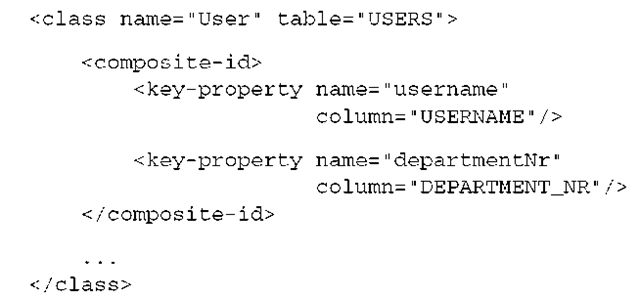
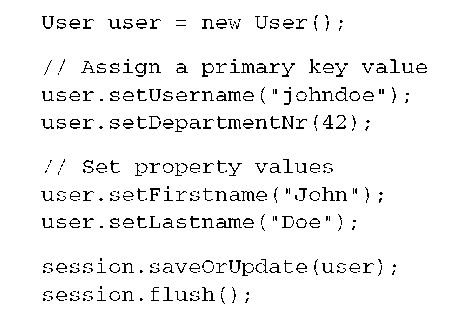
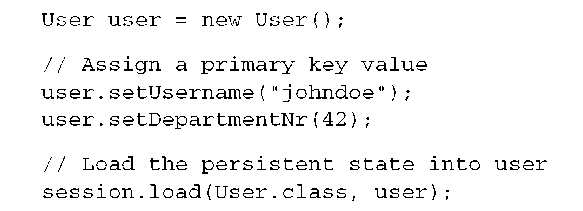

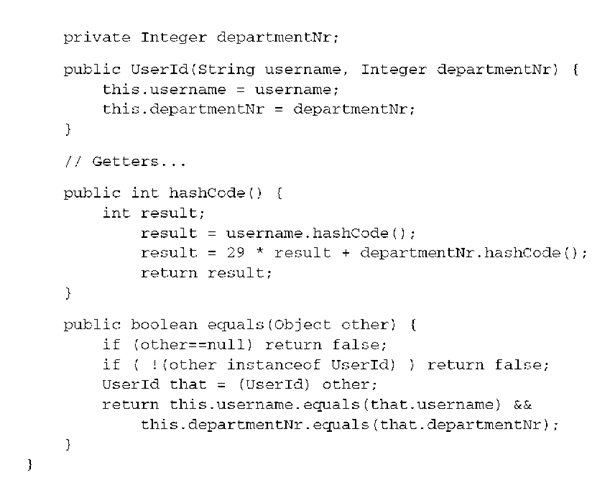

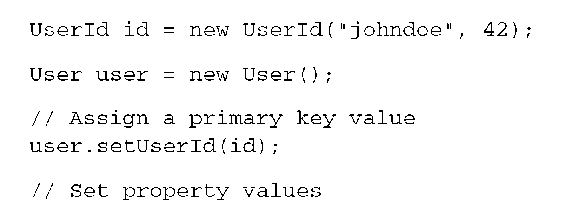
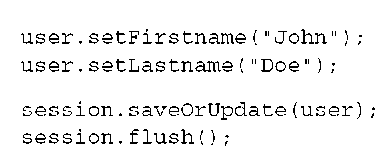

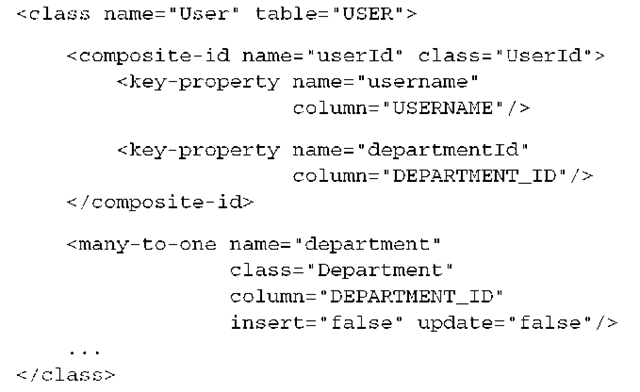

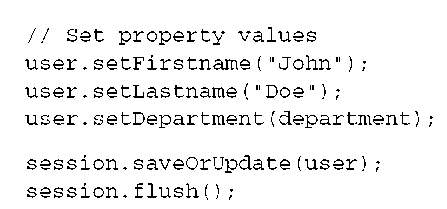
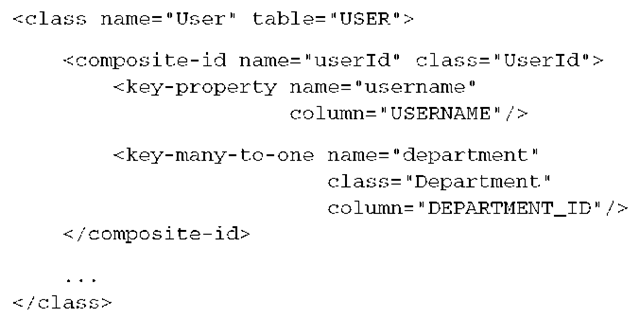





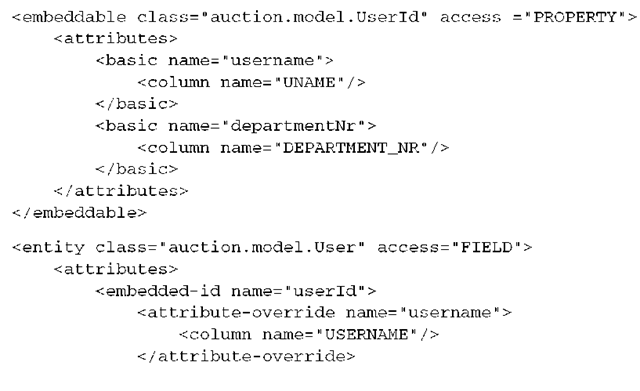

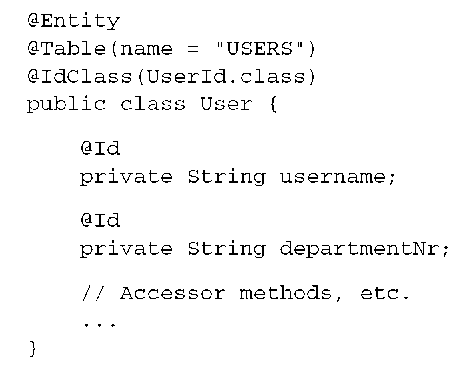




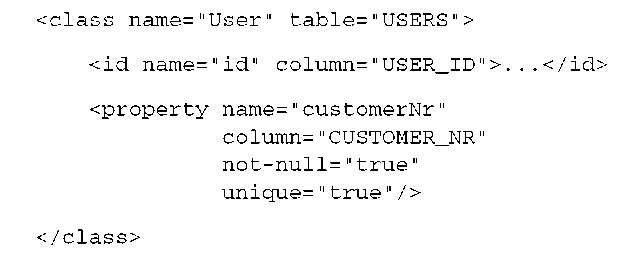





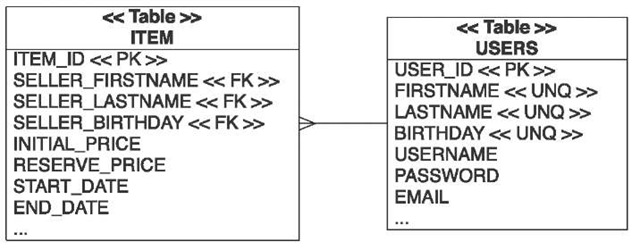
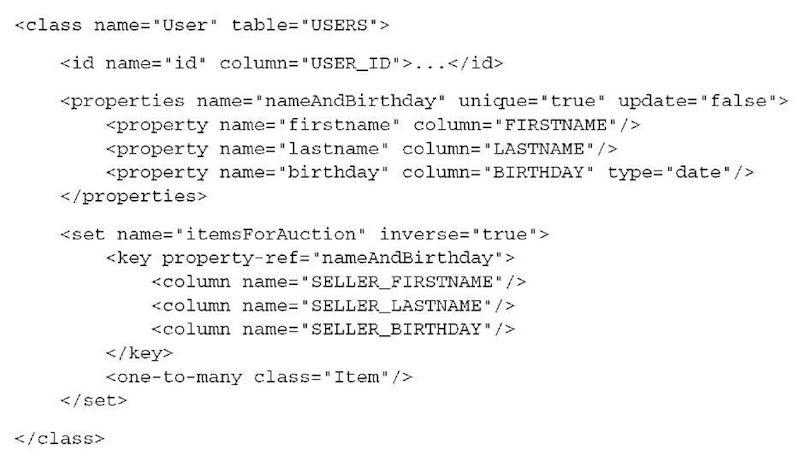

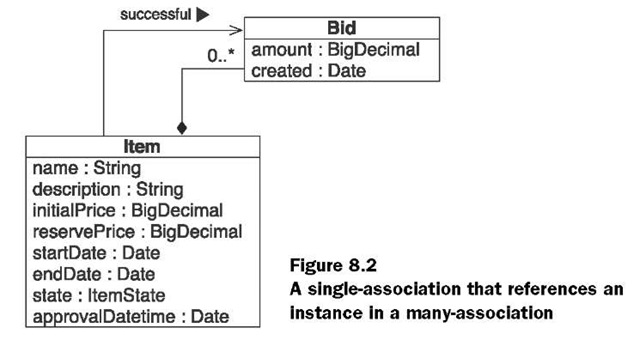
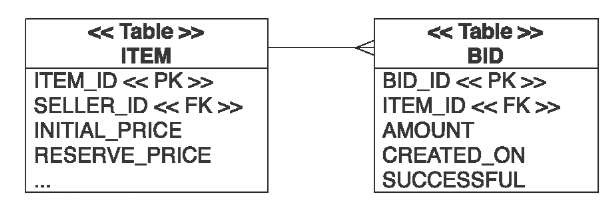

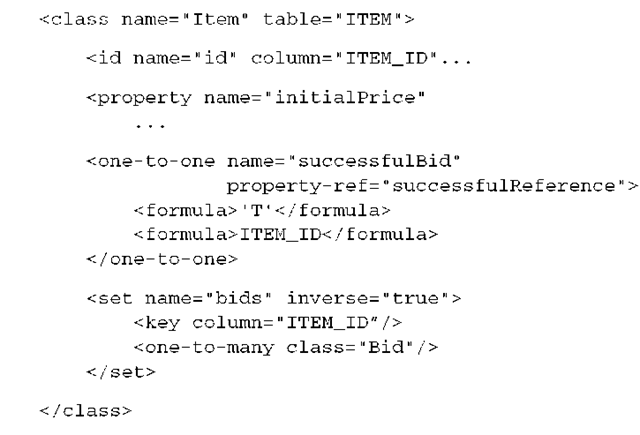
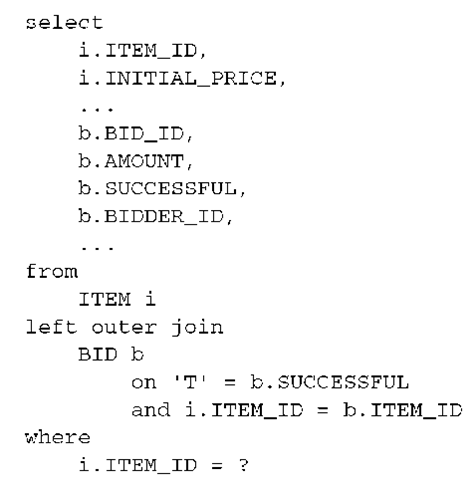

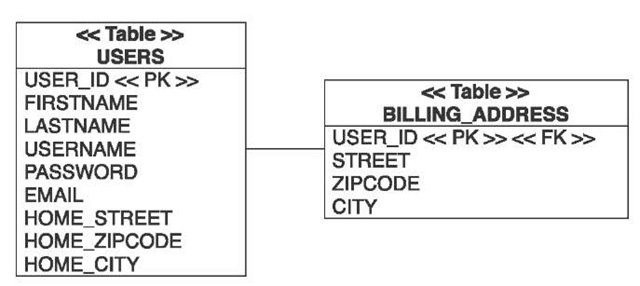
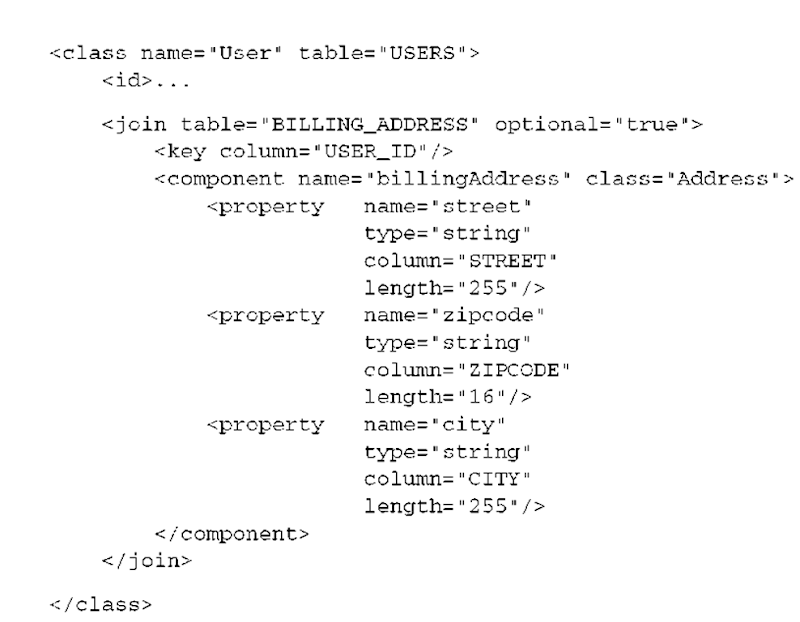
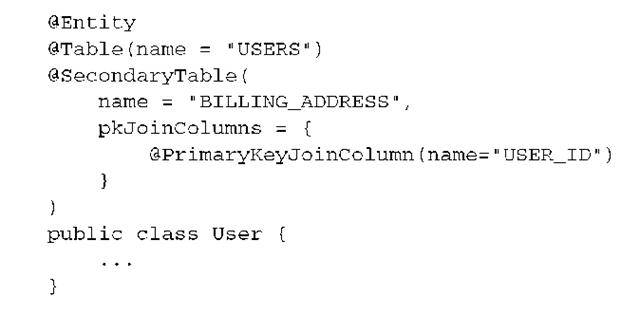
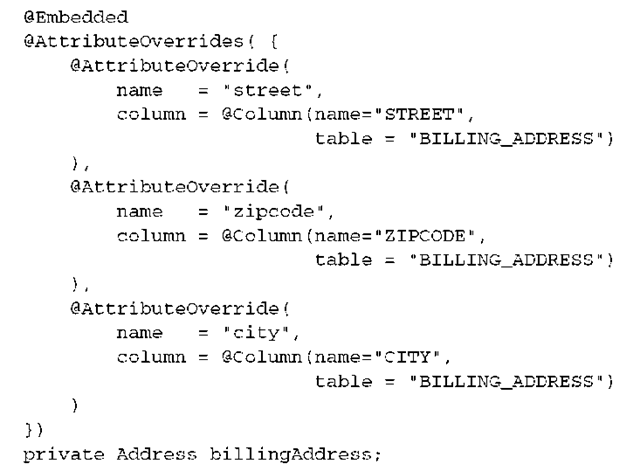
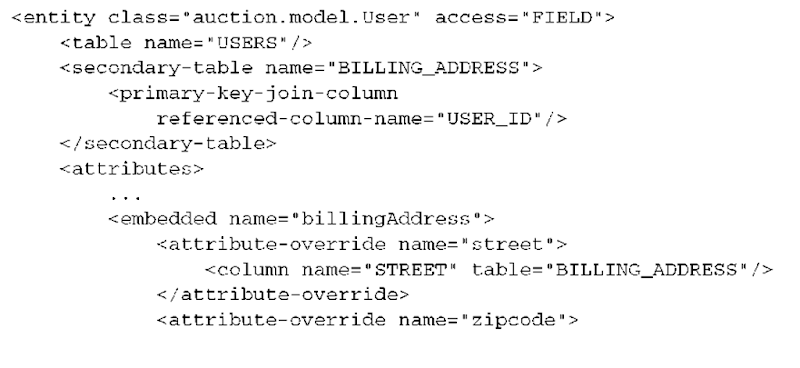

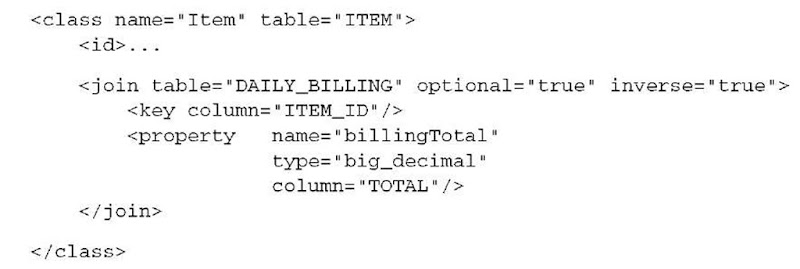

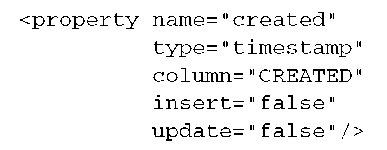

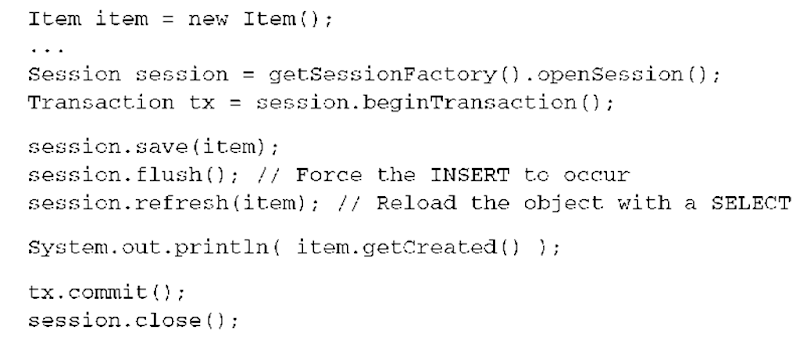
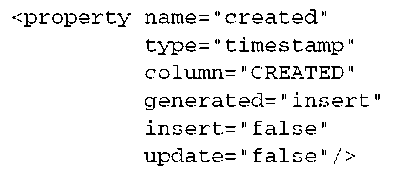

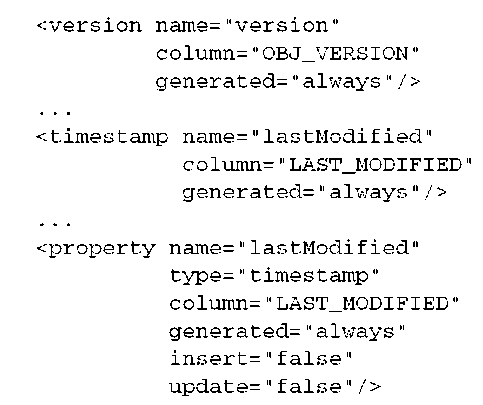
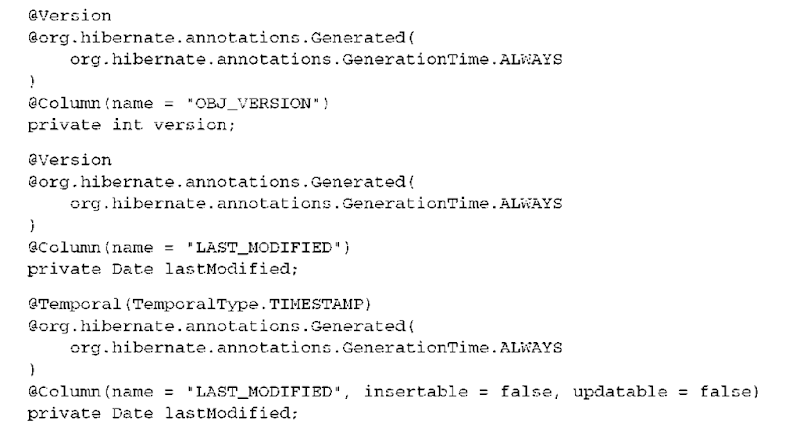




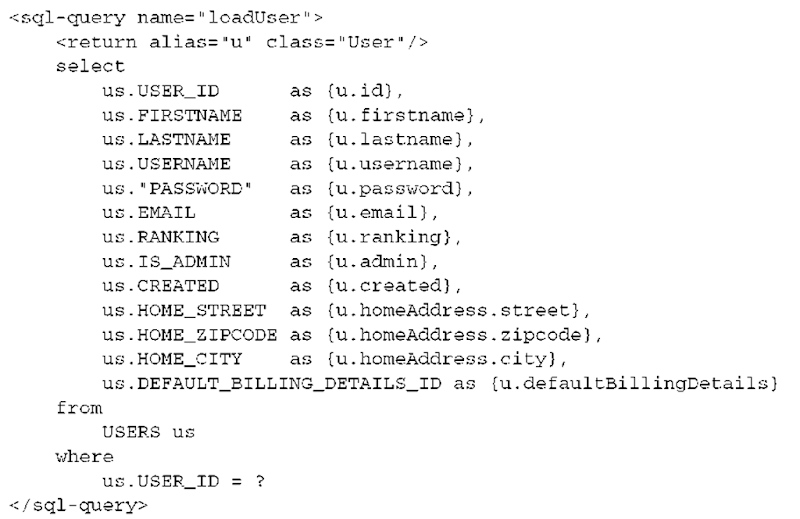

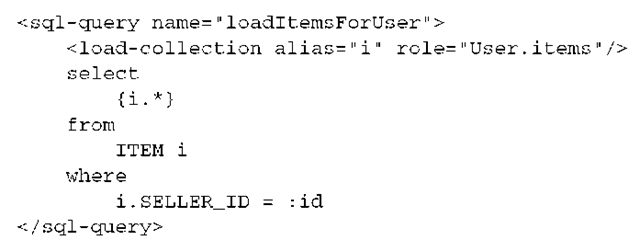

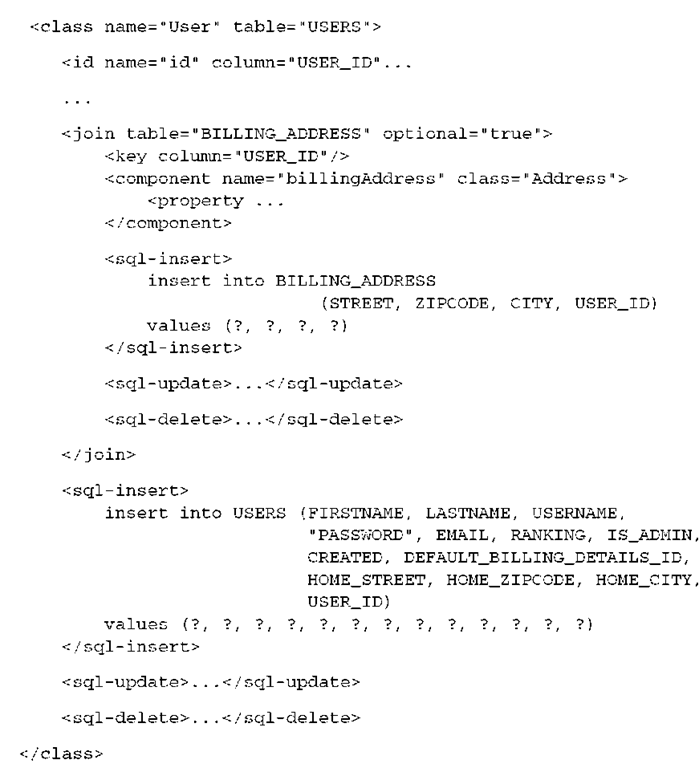

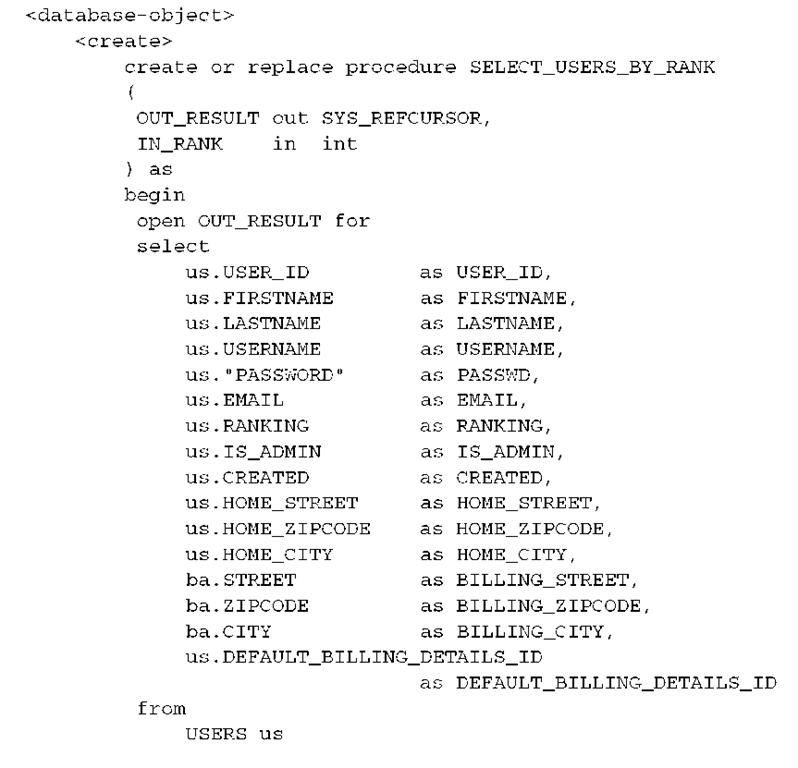
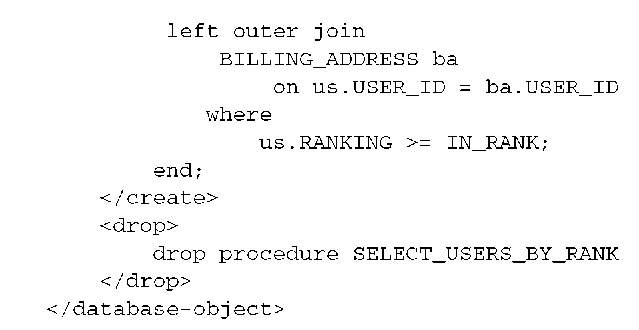
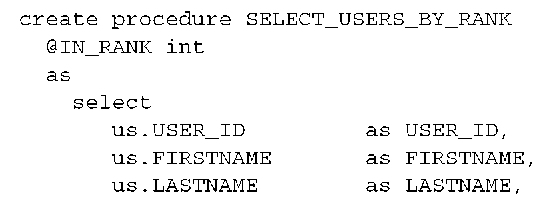

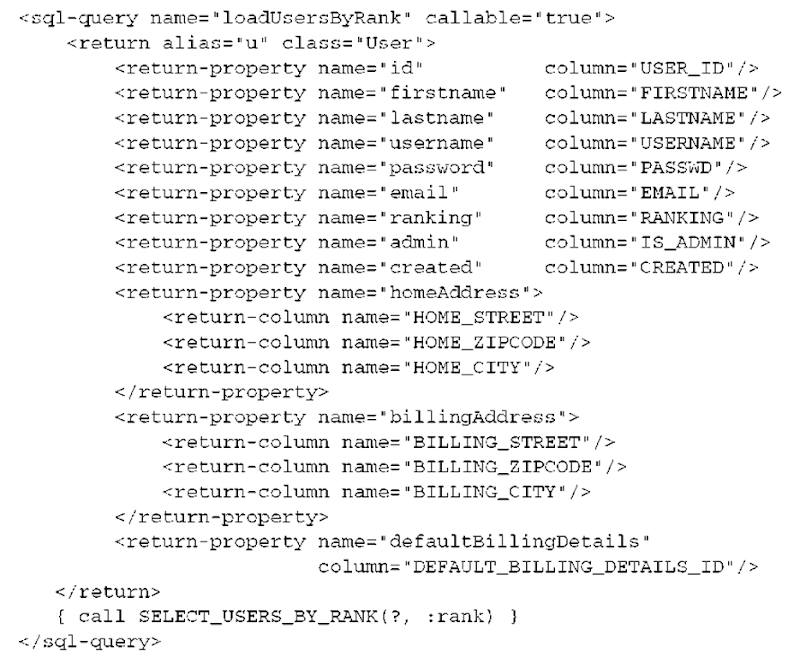




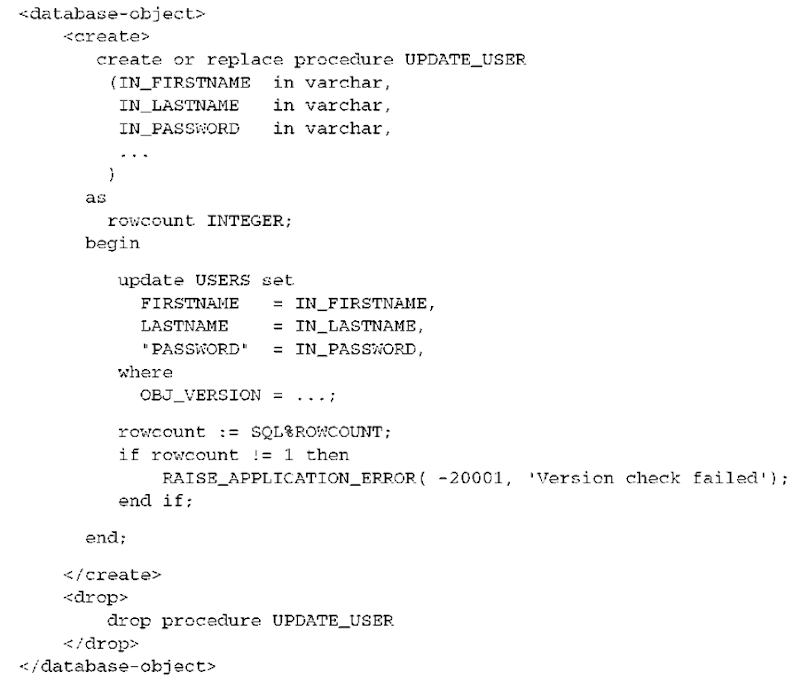
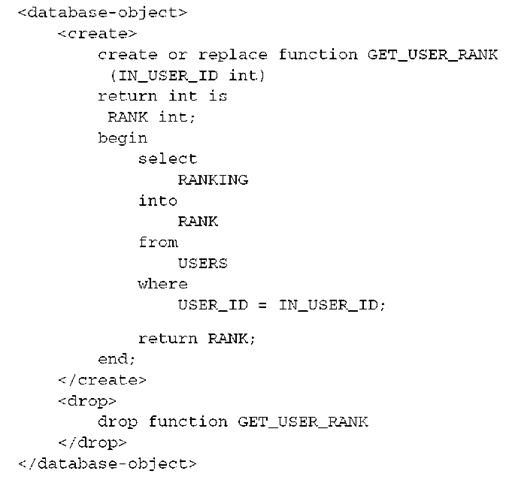


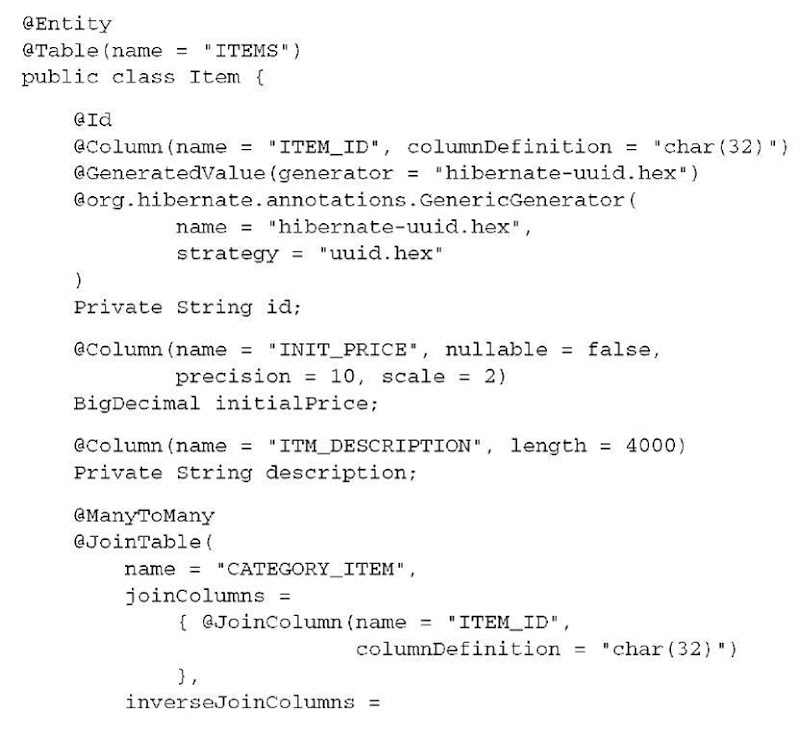


![tmp9D-4_thumb[1] tmp9D-4_thumb[1]](http://lh5.ggpht.com/_NNjxeW9ewEc/TLSAq3YBsAI/AAAAAAAAKXg/Vze7dc0ROvk/tmp9D4_thumb1_thumb.png?imgmax=800)
![tmp9D-5_thumb[1] tmp9D-5_thumb[1]](http://lh6.ggpht.com/_NNjxeW9ewEc/TLSAtV3A9gI/AAAAAAAAKXo/tV7-Tni-on0/tmp9D5_thumb1_thumb1.png?imgmax=800)
![tmp9D-6_thumb[1] tmp9D-6_thumb[1]](http://lh3.ggpht.com/_NNjxeW9ewEc/TLSAwRDJuaI/AAAAAAAAKXw/3VZVvB9JjI8/tmp9D6_thumb1_thumb.png?imgmax=800)
![tmp9D-7_thumb[1] tmp9D-7_thumb[1]](http://lh6.ggpht.com/_NNjxeW9ewEc/TLSAymvvDBI/AAAAAAAAKX4/FUTZT1uRThg/tmp9D7_thumb1_thumb.png?imgmax=800)
![tmp9D-8_thumb[1] tmp9D-8_thumb[1]](http://lh5.ggpht.com/_NNjxeW9ewEc/TLSA1Xvru7I/AAAAAAAAKYA/TBP-yx8c5uY/tmp9D8_thumb1_thumb.png?imgmax=800)


![tmp9D-11_thumb[1] tmp9D-11_thumb[1]](http://lh4.ggpht.com/_NNjxeW9ewEc/TLSA8NeT6OI/AAAAAAAAKYY/6kTeVnZpE7U/tmp9D11_thumb1_thumb.png?imgmax=800)
![tmp9D-12_thumb[1] tmp9D-12_thumb[1]](http://lh4.ggpht.com/_NNjxeW9ewEc/TLSA-kl14OI/AAAAAAAAKYg/VM43Cem-ALA/tmp9D12_thumb1_thumb.png?imgmax=800)


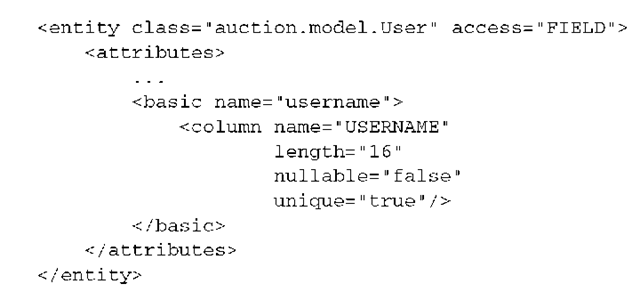

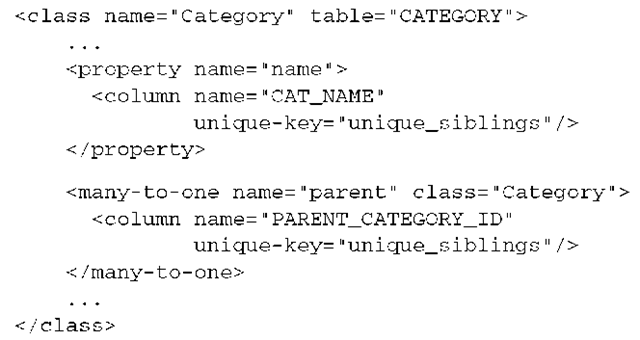
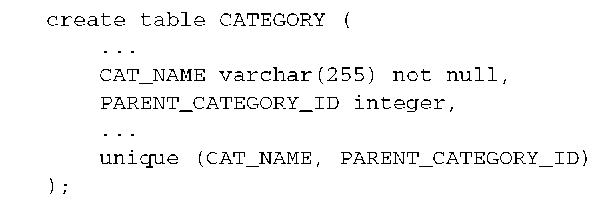
![tmp9D-19_thumb[1] tmp9D-19_thumb[1]](http://lh5.ggpht.com/_NNjxeW9ewEc/TLSBPOJoGJI/AAAAAAAAKZY/6r-XECbjIFs/tmp9D19_thumb1_thumb.png?imgmax=800)
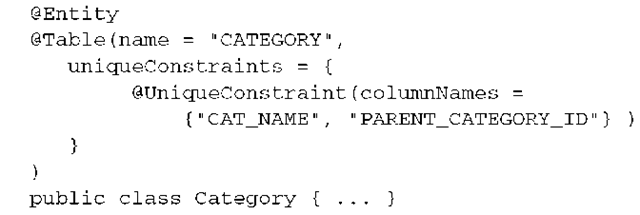



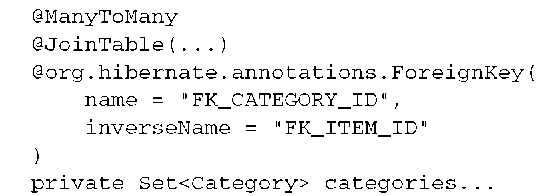



![tmp9D-28_thumb[1] tmp9D-28_thumb[1]](http://lh3.ggpht.com/_NNjxeW9ewEc/TLSBlBT6AaI/AAAAAAAAKag/a5FBRLIuro8/tmp9D28_thumb1_thumb.png?imgmax=800)


